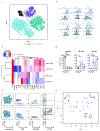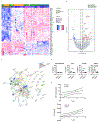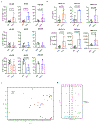A pro-inflammatory CD8+ T-cell subset patrols the cervicovaginal tract
- PMID: 31312028
- PMCID: PMC6717561
- DOI: 10.1038/s41385-019-0186-9
A pro-inflammatory CD8+ T-cell subset patrols the cervicovaginal tract
Abstract
The immune system of the cervicovaginal tract (CVT) must balance immunosurveillance and active immunity against pathogens with maintenance of tolerance to resident microbiota and to fetal and partner antigens for reproductive purposes. Thus, we predicted that CVT immunity is characterized by distinctive features compared to blood and other tissue compartments. Indeed, we found that CVT CD8+ T-cells had unique transcriptional profiles, particularly in their cytokine signature, compared to that reported for CD8+ T-cells in other tissue sites. Among these CVT CD8+ T-cells, we identified a CD69- CD103- subset that was characterized by reduced migration in response to tissue-exit signals and higher pro-inflammatory potential as compared to their blood counterpart. These inflammatory mucosal CD8+ T-cells (Tim) were increased in frequency in the CVT of individuals with chronic infection, pointing to a potential role in perpetuating inflammation. Our findings highlight the specialized nature of immunity within the CVT and identify Tim cells as potential therapeutic targets to tame tissue inflammation upon chronic infection.
Conflict of interest statement
Disclosure
The authors declare no conflicts of interest.
Figures






References
Publication types
MeSH terms
Substances
Grants and funding
LinkOut - more resources
Full Text Sources
Other Literature Sources
Molecular Biology Databases
Research Materials

